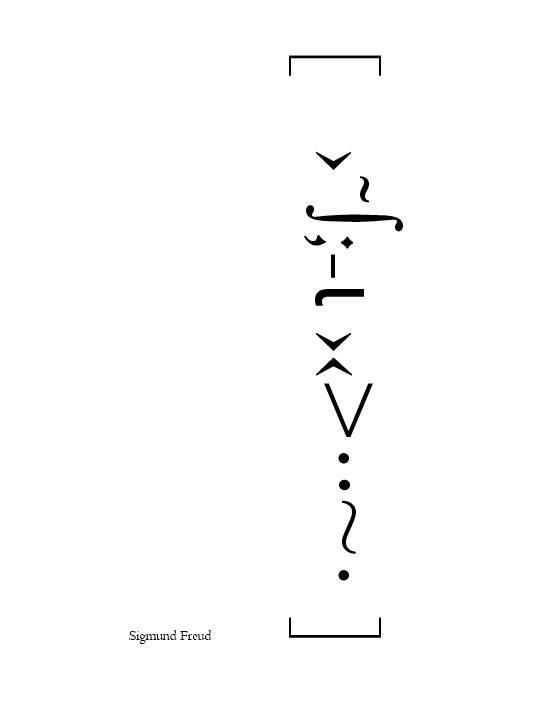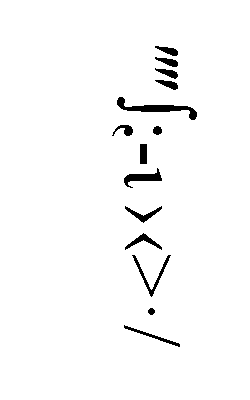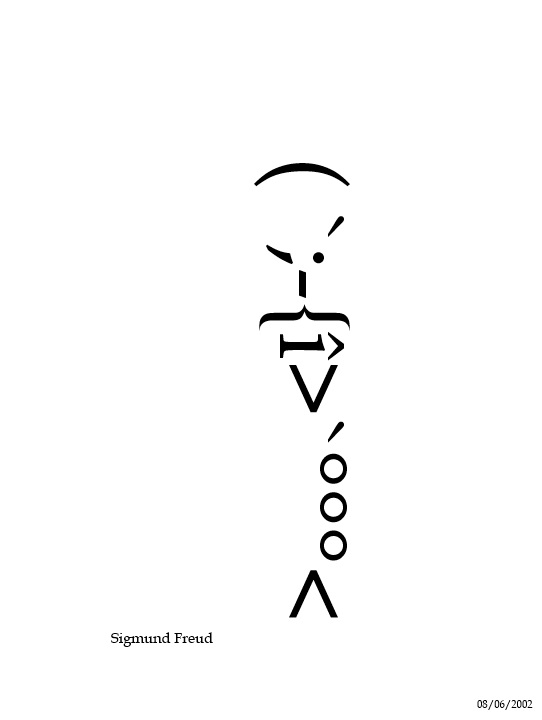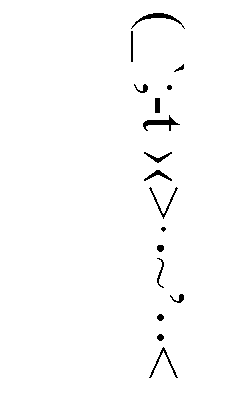A funny idea to try to build a chain-string of ascii and utf-8 characters drawing as a result a sketch matching with Freud portraits, to make him appear so ... ;-) on line!
Such a challenge it was for me in 2002 to put an in-line representation looking alike Freud...
As an analyst used to words, silence and "Hmmm" in the sessions metalanguages, signs and a symbols, inventoried in a new universal code which expands the dissemination and understanding, it was a sort of challenge to find an unexpected way to evoke Freud...
Freud opened so many new spaces to us (with opportunities to understand better, and more), now why not bring him to an updated place to sit in the digital space (with its dizzying powers of communication, memorization, computation, association and more) that he could not reach... What he would have said about it remains in question ("Smiley", he had heard about yet, ;-) but not this way). May be he would give an interested look from afar?... Anyway, questions about representations were close to the core of his business.
The pictures of Freud are quite useful: very little changes in style and appearance over the time. There is a proper look of | ( `;-ι ›‹>⋅º·~\| and his vigilance, on himself, his images and on their variability. It appears in his 1922 portrait by Halberstadt, as in that of 1926 by Ferdinand Schmutzer (he particularly thanked him for it) and which is found also in several derived engravings. He was then 70 years.
Or wearing his hat, standing outdoor of the 6th Psychoanalysis congress, on the 8th to the 11th of september 1920 in The Hague. He was 64.
Sent to the 49th IPA Congress, Boston 2015, some 95 years later, this smiley has been posted among the pictures and is still published and shared by
the IPA's Image Task Force.
[ ›˜∫;-ι ›‹>·/ ]
[ ⁗∫⁏-ι ›‹>·/ ] 

Coming with the times, reaching an achieved simplicity and the feeling gets better with a fuzzy floating visual attention.
| (_⁏-ι ›‹>⋅º·~\|
Neither the picture nor the word, it's by new means an achieved pictorial representation ... a psychoanalyst-smiley interpretation which can cause many to smile too...
The relatively small number of pictures of Freud, and their quality has made them recognized shapes.
The attention of | ( `;-ι ›‹>⋅º·~\| to its
own image becomes clear: beautiful portraits, posed regularly, honorable, with the same carefully cut and shaped
beard, often at the same angle (not that so easy, suffering from cancer of the jaw for a long time, requiring many painful operations, and distorting
his facial expression).
The possibility of making a smiley was eased by this attention to himself, with no guarantee of success either, and not so many have a dedicated smiley.
Icons ? Look now if diverting them from their function or punctuation characters, a graphic composition is reached, evocative and matching enough to be recognized in one word!
Using and combining typographic elements in a sketch evoking a famous portrait is a form of optical illusion, the one we called "smiley" born under the tight limits of the ASCII characters in the infancy years and games of personal computing, which lent to smile through the sense of misappropriation, often vertical to horizontal that it conveyed, (and characterized as an art form during a bygone era: the smiley today have become a very compact micro animated representation inserted throughout the text, with the development of computer science).

Last out, with a point of nostalgia about a yet gone away computing, these gifs, if Freud's face is telling so far something to somebody.
But with a sharper look ("Don't throw away your illusions, that's valuable matter! As illusions, of course...") we are, if you agree, closer to the ideogram or even to the pictogram, free from languages. And to understand its relationship to the word which the sequential combination of letters (and associated sounds) is conventionally a single object (or person), and maybe even poetry where words evoke associations of a particular image.
Going from and to, between association of representations to representation of associations, psychoanalysis is at work in this field, shortening paths and circuits to unharmless short circuits without any damage nor acting out, and unloading smiles.
Nowadays as the metacommunication of an emotion, and called "emoticon" for
this purpose in this so lightened shape, like an ideogram, freed of the weight of the image file by the arrangement of symbolic elements from the scansion
of languages (ie: meaning interpretation from computer language) the short-circuit of this illusion could reach a wordless witticism
like a rebus - we 're dreaming may be ... and ;-) - could we see a spark of "witz" ?
An amazing outlook is still to come : There is a more funny sequence to come ... Here is the abstract : several of the typographical
signs would be symbolizations of graphic images representing physical situations (exclamation, interrogation, reservation, closure)
where their emotional contents are generally felt.
This would be in favor of a figurative origin of the representation of typographical signs.
And the latent representations of the images of these typographical signs are entirely diverted in the composition of another image, a
representation with its share of optical illusion that takes its meaning by doubling the normal front view with a clockwise rotation at right angle. With representation of representations, we find ourselves facing metarepresentations.
Who wishes to read the details, will kindly follow on the path below.
Punctuation marks are generally considered to have distinct origins from letters, distant enough to be uncertain, even if they appear far later than writing.
The shape of Arabic numerals could be convincingly connected to the count of an equivalent number of angles on a continuous line drawn, that is to say, a pictorial
representation much more concrete and close to the banal experience.
Update the graphic interpretation and the look on these signs has found its interest through an image uniting the seemingly disparate effects in their description,
giving them meaning and origin.
And further, to be reminded, these symbols must have a shape that can be linked to a graphic content more or less consciously associated and interpreted by the reader.
For example, the point could be a stone, a pebble, allowing to identify and recover a sense to the reader, like those of Tom Thumb, or those serving for the
enumeration in its beginning.
The exclamation point [ ! ] is a sign with a point which marks an admiration, a surprise, a sudden onset, an instant shine over a shock,
a sudden bright beam, a steam leak, or a high pressure smoke eruption or an unexpected irruption of affects. Or seen from above, one looking in a special way.
The admiration is linked to the surprise, the impressive occurrence, eye-catching : ad mirare.
One of the representations of this surprise is anything that falls right there, just next, droping from above or from the sky, the free fall on the
ground of an object subject to gravity, without hurting or crushing , but that surprises, catching the eye, impresses and brings the expression of feelings.
And the isolated end point, fixed, still, finally immobile after a trace materially tapering represents well that situation which attracts attention, almost by the sound it makes.
Framed in square brackets, this seems the result on the bottom of the line of an object coming from a fall with a vaporous trail still above or an object expelling
a smoke or a steam fusing from there.
A matter of perspective, seen from above, it might be called a front view.
It would have appeared close to Florence in the late fourteenth century, but will take its final shape with the printing press.
For the question mark [ ? ], even if less obvious, the material image may still be readable: along a research path, after going straight forward,
the chosen direction is discarded for another one, then turning to still another one which does not give an answer satisfactory enough to fit
with this meaning, therefore it continues to turn around, wondering if it would be better to still influence the path towards another direction and gradually, before
turning completely round one comes to wonder which way
to go is outstanding, being assured of one thing, the point from which one wonders where to go pending a form of response, the point to which the question
refers (a reflection point?). Here, the image of the route is plotted on a
horizontal plane seen from above, before being rectified in a frontal vertical plane, facing the reader while giving him a top view more reassuring, as if it were placed above.
The bracketing would be like (the) barrel staves to retain another content than the one which flows in the main meaning of the sentence. The implementation
framework between brackets eventually isolate [better] a subject, and even put it in a safe.
So obvious are these things that no more we see them any more - but then... should it be the stamped envelope of "The Purloined Letter" ? – assuming
an -unconscious- origin of the smiley, which includes in significant images from posing or typographic elements, representations by themselves, taken for once on a graphic plan : the elements of the make up should be themselves graphic representations of different pictures !
Surprising recurrence or mirroring ?
The indexing of e motions that make the meaning of the text clearer, used this once only as on a graphic plan :
non-alphabetic conventions of punctuation would find stylized images as origin to their symbolic representations, as smileys too.
And it is the pavé de l'Ours, which is typographically linked in French by a law to every newspaper, that brought these reconsiderations far from any explicit lead on internet.
On attempts to create punctuation that meets the need to emphasize the expression of an emotion or a feeling in the text! The &lquo;point d'ironie&rquo; provides an excellent example of repeated attempts over the centuries without convincing success: they have not passed into everyday use of the written language.
The first mention is made of it in the middle of the 19th century, but it is towards its end that the most thorough effort to create and disseminate this "point d'ironie" will be made in French by Alcanter de Brahm, who will devote much to it, a lot of time, application, and means.
However, this typographical point of irony ![]() was not going to succeed in spreading, almost abandoned thereafter, although the need of its existence still seems to go on for many today readers, authors and graphic designers. The questioning of search engines is enough to be convinced of it, by the number and the variety of graphic images which relate to it and continues to increase.
was not going to succeed in spreading, almost abandoned thereafter, although the need of its existence still seems to go on for many today readers, authors and graphic designers. The questioning of search engines is enough to be convinced of it, by the number and the variety of graphic images which relate to it and continues to increase.
An article in n°60 of La cause freudienne tries in 2005 to find the reasons for the failure to spread from the "point of irony" in its very insistence on signaling the second degree of the meaning of the words that precede it, spoiling the lightness and double meaning of the subject that the reader would like to guess himself. (Already originally, the term "point of irony" is ambiguous enough to create a double meaning in the reader's mind.)
Without calling into question the relevance of the mechanisms selected, the explanation appears to be of a very different order: whatever the need felt by the authors and the readers, it is the absence of relations between the graphic design (from point d 'irony) and a pictographic expression easily linked, interpreted and memorized, evocative of irony, which would rather be the cause of it.
The paragraph Emploi (Use), from Wikipedia's "Point d'ironie" echoes it: The problem is obviously due to the fact that unlike laughter or smile, irony has no visible physical expression, apparent, unambiguous, easy to understand and to represent: it conceals, even discreetly hidden, delayed, a small or great wickedness, the meaning of which could even go unnoticed, and this is why the question of its markup continues to arise. Challenge to artists, what tiny partial image could surely be reminiscent of irony? A knowing half smile? In Scott Fahlman's sequel, that's what the smiley ;-) succeeds to express.
The ongoing digital revolution has passed the "point of irony" ![]() initiated by Alcanter de Brahm , now with a collection of smileys, emoticons and emojis widely spread to express a full range of feelings.
initiated by Alcanter de Brahm , now with a collection of smileys, emoticons and emojis widely spread to express a full range of feelings.
* That past computer history has recently come back in view as the MoMA of New York acquired and exhibited the complete collection of the first emoji created in 1999, the number of emoticons and emojis, replacing or not smileys, has resumed and their use goes increasing in messages. Many sites list the creations, their utility to replace words or expressions, or dedicate themselves to this art form now recognized.
¤ Bibliography:
Langue française, n ° 45, 1980. La ponctuation. (ed. Larousse)
- Nina Catach. (éditeur intellectuel du numéro de cette revue) Présentation . In: Langue française, n°45, 1980. La ponctuation. pp. 3-7.
(This presentation is a very remarkable synthesis).
- Claude Tournier, Histoire des idées sur la ponctuation, des débuts de l'imprimerie à nos jours. sur l'histoire
(A very complete and well-documented article on the appearance of punctuation (of which he gives a definition), the vicissitudes of its establishment, its variations and its evolution.) The appearance of punctuation marks takes place separately and after that of alphabetic characters, in the form of different points among the Greeks and the Latins, and more closely to current use, from the 16th century with Étienne Dolet in France.
These reference articles were not yet accessible by internet at the time of the construction of this page, which can complete (after the declamatory, semantic, and syntactic functions) an aspect not addressed in this n ° 45 on punctuation, with a hypothesis on the pictographic origin of the very form of the ideograms which are retained as punctuation marks, making it possible to understand how some are retained (or not) durably in the language (or even the) language (s), this supposing an economy of means bringing together the density, brevity, simplicity and sharpness of the association evoked by the punctuation glyph.
¤ Punctuation has an already long history: a quote, dated 1568, from Jean Bosquet, Grammarian teacher in Mons:
“- An interrogant means raising and lowering the voice in a tone appropriate to the words.
- An admiratif translates different feelings, with amplification or flexion of the voice, according to the affection of the prayer: that is to say
in a harsh, shrill, rushed, interrupted, lamentable, or pleasant, and joyful voice.”

Here is the first smiley of Freud in 2002... an attempt to insert in 2002, an in-line representation of Freud, in the
study on "The Wolf and the Lamb" !? ...
( `;-{î>`°°°<
(https://web.archive.org/web/20020608034036/http://ohana.marc.free.fr/leloupetmarcohanauna.htm)
FILE ARCHIVED ON 3:40:36 juin 8, 2002 AND RETRIEVED FROM THE INTERNET ARCHIVE ON 16:17:05 juin 9, 2014
Thanks to the web archives !
Anyway, it was not fitting very well, even with a psychoanalyst's sight."
Pictures are interpretations already, and their silence is interpreted too. The question of silence is at the foundation of psychoanalysis, and at the beginning of mine and the one of my first analyst too(?), building a fake quote of Lacan telling about blind spaces of unsaid between speech, slips, and dreams revealed by scansions in the speech, was a track to a former attention to this question.
"Sur le métier, remettez votre ouvrage", "Travaillez, prenez de la peine, c'est le fonds qui manque le moins !"... as
told by Jean de La Fontaine
Developing imagination and an orthogonal view, thinking by side is not thinking through, if one follows in tracking.
Yes, but how to do things wrong, I know: there was a closer release than the first published !
Horror, unfortunately, in the cooking of the fifteenth amended release, it had been erased by accident, and no more valid copy of that one, vanished !
Just kept in mind that a better outcome is possible, and some details of improvements recorded over the years.
It lasted a very long time before I've found it back (with those old 7 bits ascii caracters, indeed).
( `;-i>`>-~~<
From the begining, it was clear it looked better in "Times New Roman". And strange in Courier, or later in Chiller!
| ( `;-£›‹>⋅⋅º·\ |
| ( `;-€›‹>⋅⋅º·\ |

Here above, drafts using the sterling pound or the euro, meanwhile arrived:
Slights changes makes faintly different the rendering (using blinking and floating look), sometimes a little closer to the photo by Schmutzer or by Halberstadt.
[ ( `;-í ›‹>⋅⋅º~⋅< ]
Tests of smileys closer to Schmutzer's snapshot or closer to Halberstadt's, it is a matter of visual illusion.
Indeed, the police is important, serif is more expressive.



The fun in the last one: asymetry due to letter f twisting but creating a perspective as to look facing him, slightly downward to his leftside, and this "f" leads more or less inconsciously to his name.

[ ( `⁏-t ›‹>⋅º·~\]
[ ( `;-í ›‹>⋅º·~\]
[ ( `;-t ›‹>⋅º·~\]
[ ( `;-f ›‹>⋅º·~\]
a little closer hereabove of the portrait by Smutzer, 1926
and hereunder, of Halberstadt's, 1922
| (_`⁏-ι ›‹>⋅⋅ ~’⋅ < |
| (_`⁏-t ›‹>⋅⋅ ~′⋅ < |
| (_`⁏-f ›‹>⋅⋅ ~′⋅ < |
| (_`⁏-í ›‹>⋅⋅ ~′⋅ < |